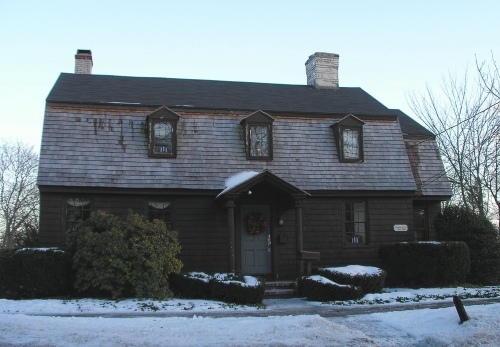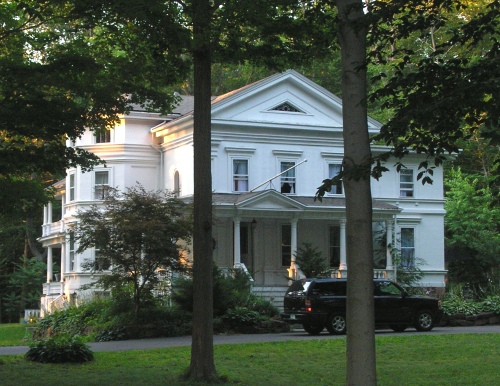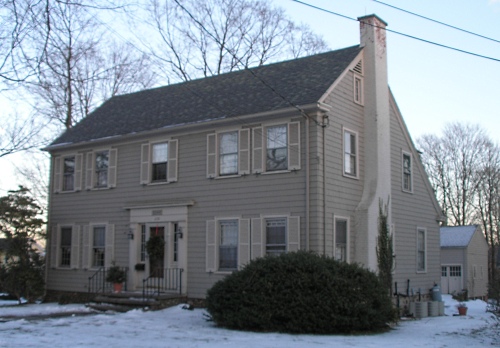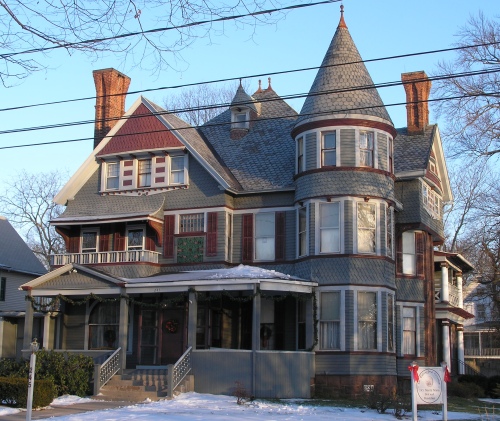The Augustus Hall House (1760)
Wednesday, March 30th, 2011 Posted in Colonial, Houses, Wallingford | No Comments »
At 198 Main Street in Wallingford is the Augustus Hall House, built in 1760. It has a similar appearance to the nearby Samuel Parsons House, but has an asymmetrical front facade. The smaller north chimney is probably a later alteration.
The Samuel Simpson House (1840)
Thursday, September 9th, 2010 Posted in Greek Revival, Houses, Wallingford | No Comments »
Architect Henry Austin designed the home of Wallingford industrialist Samuel Simposon, which originally stood on North Main Street in Wallingford. In the mid-nineteenth century, Simpson, a silver manufacturer, partnered with Robert Wallace in the firm of R. Wallace & Company, the forerunner of Wallace Silversmiths. He was later president of Simpson, Hall & Miller. Simpson’s great-granddaughter, Margaret Tibbits Taber, later had a bookstore in the house. The home was later moved to its current location on Scard Road in Wallingford.
Hall Elton Building (1847)
Monday, January 18th, 2010 Posted in Commercial Buildings, Second Empire, Wallingford | No Comments »
The date for the Hall Elton Building in Wallingford is 1847. The structure must have been updated in the Second Empire style, with a Mansard roof, later in the nineteenth century, as the Second Empire style did yet exist in 1847. A number of silver companies occupied the building and in 1988 it was restored to house offices. Hall, Elton & Co. was a silver company founded in 1838 through an association of Deacon Almer Hall, William Elton and others to produce German silver and britannia wares.
The Samuel Parsons House (1759)
Monday, March 9th, 2009 Posted in Colonial, Houses, Wallingford | No Comments »
Built around 1759, the Samuel Parsons House, on Main Street in Wallingford, once served as a tavern when stage coaches stopped there. Featuring many traditional colonial elements, the house is transitional in style because it also has features of the Georgian style, including its two chimneys and the way its rooms are arranged inside. Caleb Thompson bought the house in 1803 and built wagons, carriages, and coffins in his shop on the property. His granddaughter, Fannie Ives Schember, leased the house to the Wallingford Historical Society in 1919 and later left it to the Society in her will. Owned by the Society since 1932, today the house is a museum.
The Rev. Samuel Street House (1673)
Thursday, January 29th, 2009 Posted in Colonial, Houses, Wallingford | 1 Comment »
On South Main Street in Wallingford is the home of Reverend Samuel Street, built in 1673. Samuel Street was the town’s first minister and one of its first settlers, being one of the original 39 signers of the 1668 Wallingford Agreement, or original covenant of the first Wallingford planters. Rev. Street‘s daughter, Mary, married John Hall. Their son, Lyman Hall, Street‘s grandson, was a signer of the Declaration of Independence. Rev. Street, who died at age 82 in 1717, served as minister for 45 years.
The Rev. James Dana House (1760)
Monday, January 26th, 2009 Posted in Colonial, Houses, Wallingford | No Comments »
The Rev. James Dana House was built around 1760. Rev. Dana was Pastor of Wallingford’s First Congregational Church during the period of the Revolutionary War. When Rev. Dana arrived from Cambridge, MA to become the church’s minister in 1758, he was soon at the center of what would be called the “Wallingford Controversy.” Dana was supported by those called “Old Lights,” who opposed the “New Light” evangelical preachers of the Great Awakening. As explained by Charles Henry Stanley Davis, in his History of Wallingford (1870), “Dr. Dana was understood to be of the then liberal school of Boston and that region, and of that party which had opposed the revival of religion; his settlement in so large and important a church, would be a triumph of that party, which had already become a minority in the county and in the colony; and therefore the new light men were determined by all means to prevent the ordination, and when the thing was done to undo it if possible.”
According to Gideon Hiram Hollister’s History of Connecticut, Vol. 1 (1858), Dana was settled as minister in Wallingford, “in opposition to a large proportion of the members of the society. It was contended by his opponents that he was not orthodox in sentiment; that he had evaded the enquiries of the committee as to his views on important doctrinal points, and finally replied impertinently; and, after his alleged ordination, it was claimed that the ordination was not valid.”
The Congregational consociations of New Haven and southern Hartford counties joined to declare a sentence of non-Communion against Dana and the Wallingford church. As George Punchard wrote, in his History of Congregationalism, Vol. 5 (1881), the controversy, “resulted in a division of the church, and the formation of a new one by the disaffected brethren, some of whom were among the most influential men of the town. From Wallingford the controversy spread all over the colony, and continued for years, alienating brethren and dividing churches.” Some years later, in 1772, a kind of amnesty was eventually declared for Dana and his church and some of his old opponents were reconciled with him. An example of one of Rev. Dana’s sermons is one he gave on The African Slave Trade in 1791. Dana left Wallingford in 1789 and lived in New Haven until his death in 1812.
The Charles Tibbits House (1891)
Sunday, January 25th, 2009 Posted in Houses, Queen Anne, Wallingford | 1 Comment »
The Queen Anne-style Charles Tibbits House was built on North Main Street in Wallingford in 1891 by Gordon W. Hall as a wedding present for his daughter, Georgianna, who had married Charles H. Tibbits. Hall was a founder of the silver manufacturers, Simpson, Hall, Miller and Company. Designed by the New Haven firm of Allen and Tyler, the house was constructed by the C.F. Wooding Company of Wallingford. Sold in 1961 to a doctor who reconfigured the interior, the house has been been restored since the 1990s to be a Bed & Breakfast called the Wallingford Victorian.










No comments:
Post a Comment